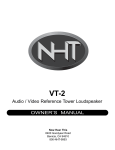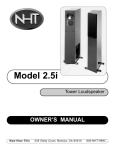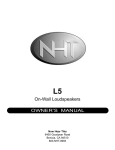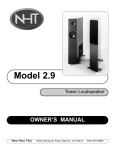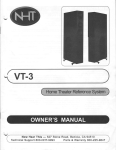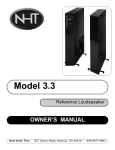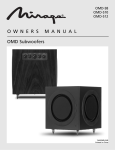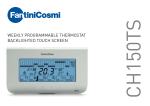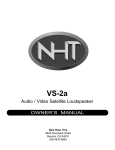Download NHT VT-1.2 Speaker User Manual
Transcript
Model VT-1.2 Audio / Video Tower Loudspeaker OWNER’S MANUAL Now Hear This 6400 Goodyear Road Benicia, CA 94510 800-NHT-9993 Thank you for your purchase of the NHT Model VT-1.2 Audio / Video Tower Loudspeaker. Please take a few minutes to read through this Owner’s Manual prior to installing your new speakers. The information provided will help you to obtain maximum performance from your audio system. If you have questions or need assistance at any time during the installation or operation of your new speakers, please call your NHT Dealer or our Toll-Free Customer Hotline at: 1-800-NHT-9993 Please retain the Model VT-1.2’s packaging to protect the speakers in the event that you move or transport them. Model VT-1.2 Specifications · System Type: 3-way vented design · Driver Complement: 8” long-throw subwoofer, two 4.5” midranges, 1” fluid-cooled soft dome tweeter, video shielded (upper portion only) · Crossover: 120Hz 6dB/octave high-pass and 12dB/octave low-pass Audio mode: 2.2KHz 12dB/octave high-pass and low-pass Video mode: 2.2KHz 12dB/octave high-pass and 6db/octave low-pass · Response: 33Hz - 21KHz, +/- 3dB · Sensitivity: 86db (2.83V at 1M) · Impedance: 8 ohms nominal, 5 ohms minimum · Recommended Amplifier Power : 35W/ch minimum, 200W/ch maximum · Inputs: 1 pair of 5-way binding posts for woofer input 1 pair of 5-way binding posts for mid/high input · Weight: 42 lbs. each · Dimensions: 38”H x 5.5”W x 15.75"D · Finish: High gloss black laminate Specifications are subject to change without notice, in accordance with our policy of continuously upgrading the performance of our products. Design NHT speakers are designed to deliver refined, musical sound from attractive and affordable packages. Our efforts are guided by the study of human hearing and are optimized for real-world use. Every NHT loudspeaker undergoes rigorous testing and quality control at the factory to ensure you years of listening pleasure. Designed as a smaller and more affordable counterpart to NHT’s revolutionary VT-2 Audio / Video Reference Speaker, the VT-1.2 incorporates many of its larger sibling’s technologies, including an easily accessible Audio / Video switch on the front panel. The VT-1.2’s are designed to provide high-performance sound when used as main L-R speakers in five-channel home theater systems (such as Dolby Digital® and Pro-Logic®). The VT-1.2 Towers employ the identical midrange and high frequency drivers as the companion VS-1.2 Audio / Video Satellite, which is recommeded for use as center and surround speakers to provide matched timbre in all five channels. Inside the VT-1.2 are two separate chambers. The midrange and high frequency drivers are housed in a sealed sub-enclosure and located on a narrow front baffle. The 8-inch long-throw subwoofer is housed in a separate vented enclosure and is mounted on the side of the cabinet for consistent bass loading. fig. 1 Audio / Video Switch The Audio / Video Switch on the front baffle of the VT-1.2 (fig.1) makes it an ideal speaker for combined audio / video systems. The “Audio” mode (A) provides impressive imaging for music playback, while the “Video” mode (V) broadens the soundfield horizontally for a diffuse, ambient presentation. This “smearing” of the sound in the “Video” mode greatly minimizes the occurrence of cognitive dissonance, a psychoacoustical phenomenon which occurs when an onscreen visual image is accompanied by a sound that is placed offscreeen in a precise location. NHT’s Audio / Video switch is a means for optimizing the speaker during home theater use to minimize cognitive dissonance, which confuses sensory perception and can compromise the realism of the experience. 2 Placement The Model VT-1.2 is a floorstanding loudspeaker that requires no stands or mounting hardware other than the included SpikeKit. The VT-1.2 is designed for indoor use only. For best results, the VT-1.2’s are best situated at least six inches from the rear wall (due to the rear vent) and at least one foot from the side walls. The speakers should be arranged as symmetrically as possible so that the drivers face the listening area without obstruction from furniture. With the VT-1.2’s set up properly, the side-firing woofers face to the outside (away from the TV) and the tweeters are at approximately ear level. If possible, arrange the speakers so that the distance between the listener and the center of the speaker plane is about 1.5 times the distance between the two speakers (fig. 2). This configuration puts the listener in the center of the stereo image. The upper portion of the VT-1.2 features magnetically shielded drivers, allowing the speakers to be placed in close proximity to a television without causing picture discoloration. Ideally, the three front speakers in a home theater system should be placed at equal height, equidistant, and at ear level from the listening position. However, it is frequently not possible to install a center speaker at ear level, as the top surface of most televisions tends to be higher than ear level in the seated position. In this case, it is advantageous to tilt or aim the center speaker toward the listening position. Experimentation is the key to finding the best arrangement in your listening environment. Be patient, have fun, and remember that small changes in speaker position can sometimes have a significant effect on the sound. For example, moving the speakers nearer to a room boundary (walls, corners) will tend to increase their bass output, but may result in “boomy” or “muddy” sound. Conversely, placing the speakers farther away from room boundaries will tend to decrease their bass output, but may result in greater articulation and better imaging. In addition, room furnishings play an important role in absorbing and reflecting soundwaves. Midrange and high frequencies in particular will be absorbed by soft furnishings such as sofas, carpets and curtains. A large number of these soft furnishings will dull the sound, while a “live” room with few furnishings will brighten the sound. If you are willing to spend fig. 3 fig. 2 some time fine-tuning the performance of your system, you will enjoy the benefits for years to come. SpikeKit Installation A SpikeKit is included with the Model VT-1.2 to provide optimum stability and to firmly couple the speakers to the floor for improved bass performance. Each VT-1.2 loudspeaker is shipped with its own SpikeKit. Caution: the VT-1.2 is unstable without the SpikeKit (or at least the stabilizer bars) installed. To begin assembly, unpack the SpikeKit and inspect all the parts. The SpikeKit includes: (2) stabilizer bars, (4) metal spikes, (4) Phillips head machine screws, (4) lock nuts and (4) rubber feet. We recommend installing the spikes only after you have found the ideal location for the speakers. Begin by installing the stabilizer bars. Carefully turn the speaker upside down or on its back and attach the stabilizer bars with the Phillips head machine screws, using a #2 Phillips screwdriver (fig. 3). Note: When installing the bars onto the bottom of the speaker, use your fingers to start all the machine 3 screws in their holes before tightening them down. This will prevent crossthreading. Before installing the spikes, turn the speakers upright and position them. When you have found the perfect spot, carefully tilt the speakers and screw in the spikes with the lock nuts on them. The speakers are awkward to move after the spikes are installed. Caution: The spikes are very sharp. To avoid injury, use extreme care when handling and installing them. Adjust the spikes as needed to ensure that the VT-1.2 is level and does not rock in any direction. Tighten then lock nuts against the bottom of the stabilizer bar to lock the spikes in place. If you have hardwood floors or floors with a scratchable surface, you may choose not to use the spikes because they will pierce the surface. Rubber feet are provided and can be used in place of the spikes. Install the stabilizer bars, peel off the adhesive backings from the rubber feet, and place them over the holes where the spikes would screw in. Connections Before connecting speakers to your system, it is very important that you turn off the power to your amplifier / receiver to avoid damage to the equipment. On the back panel of the VT-1.2 there are two sets of binding posts (fig. 4) with a metal jumper strap connecting the top and bottom posts. There are three different ways to connect the VT-1.2’s to your system: Full-range with a single amplifier / receiver, Bi-amplified with two amplifers and two sets of speaker wire, or Bi-wired with one amplifier and two sets of speaker wire. To run the VT-1.2’s full-range with one amplifier / receiver, simply connect the speaker wires to either the top set or bottom set of posts (it doesn’t matter which one). Bi-amplification is the use of two separate amplifiers, one to power the bass drivers and one to power the midrange / high frequency drivers. This configuration provides greater dynamic range for both amplifiers, as they are spared the task of reproducing the entire frequency range. In addition, bi-amplification is a great advantage in home theater systems, as it turns the passive subwoofer section of the VT-1.2 into a powered subwoofer. NHT’s SA-2 and SA-3 subwoofer amplifiers are optimized for subwoofer amplification and feature adjustable volume and bass tuning functions, which allow the user to fine-tune bass response for an individual listening environment. Note: It is very important that you remove the jumper straps when bi-amplifying or you will damage your amplifiers! To bi-amplify the VT-1.2, you will need two amplifiers, one for the upper range drivers (top pair of binding posts) and one for the subwoofer (bottom pair). Connect one pair of binding posts with speaker wire from one amplifier, and the other pair of binding posts with speaker wire from the second amplifier. If you have an audio / video receiver, you may use its front left and right speaker outputs to drive the upper section, and a separate amplifier for the subwoofers. It is important to achieve level matching between the two amplifiers. Use either two identical amplifiers, or make sure that one amplifier has a volume control. Both amplifiers will need to receive an identical line-level signal from the preamplifier/processor or “pre-out” jacks of the A/V receiver. If only one set of “preout” jacks are available, use a “Y” splitter in order to send the signal to both amplifiers. For more detailed information about biamplification, contact your local authorized NHT retailer. Some audio enthusiasts have found that bi-wiring can bring about improvements in sound. Bi-wiring is the use of two pairs of speaker wire and one amplifier, with each pair connected to one set of binding posts on the amplifier (some two-channel amplifiers provide two sets). To bi-wire the VT-1.2’s, connect the top pair of binding posts to the amplifier with one speaker wire, and the bottom pair with a second wire. The two sets of speaker wire are both connected to one pair of terminals on the amplifier. fig. 4 The Model VT-1.2 loudspeaker system is compatible with virtually all quality amplifiers. Proper wiring of the speakers is essential to good sound. At a minimum, 14AWG wire is recommended for runs of 10 feet or less, with heavier special purpose speaker wire used for longer runs. For specialty wire considerations, consult your local authorized NHT retailer. For best results, use equal length runs of speaker wire for the left and right speakers. Prepare your speaker wire by stripping 1/4” to 3/8” of insulation from the ends and twisting the exposed wire strands tightly. The five-way binding posts on the back of the speaker will accept raw wire, banana plugs, or spade plugs. Tighten the binding posts by hand, as pliers can strip or break them. Be sure to wire both the left and right speakers "in-phase." That is, the Positive (red) terminal on the amplifier output must be connected to the corresponding Positive (red) terminal on the speaker. Likewise with the Negative (black) terminals. All speaker wires have some sort of marking along one or both conductors to help you make the correct connections. Incorrect speaker phase is indicated by weak bass and the lack of a well-defined stereo image. To minimize noise pickup, segregate cables by function. Do not run low level signal cables parallel to power cables, speaker cables, or digital cables. Also, do not run speaker cables or digital cables parallel to power cords or parallel to each 4 other. If different types of cables are placed near each other at some place in your system, separate them by the maximum practical distance and cross them at right angles where they meet. Do not twist or tie AC power cords with speaker cables. Operation The Model VT-1.2 was designed to handle a wide range of listening levels, but every speaker has limits. It is important to use common sense and listen for signs of possible distress from the speakers. Underpowered amplifiers are most often the cause of speaker damage. For example, a 60-watt amplifier runs out of power when called upon to produce more than 60 watts, and the resulting distortion can damage the speaker. If you tend to listen at high volume levels, more powerful amplifiers are preferable becase they are less likely to run out of power. Noticeable distortion or harsh breakup is an indication that either your amplifier or your speakers are running beyond their capacity, and the volume should be decreased. If you can feel any heat emanating from the woofer or tweeter, reduce the level immediately. Speaker damage most often occurs from sustained high volume levels, not from transient sounds or brief musical peaks. Excessive boosting of bass, treble or equalizer controls can worsen the problem, and is not recommended. Maintenance Your speakers require minimal maintenance under normal use. The cabinet may be cleaned using a damp cloth or a mild, non-abrasive cleaner. To clean the grille, first remove it from the speaker, then brush lightly with a soft brush or use a vacuum on its lowest setting. Do not expose the speakers to direct sunlight, high temperatures, or moisture. Do not attempt to clean the actual drivers. Warranty Valid Only in the U.S.A. Warranty Period For the period of 5 years for parts and 5 years for labor from date of original purchase (the warranty period) from an authorized NHT dealer, Now Hear This (NHT) warrants that if our product fails to function properly under normal use due to a manufacturing defect when installed and operated according to the owner’s manual instructions enclosed with the unit, it will be repaired or replaced with a unit of comparable value at the option of NHT without charge to you for parts or actual repair work. Parts supplied under this warranty may be new or rebuilt at the option of NHT. What’s Not Covered This warranty does not cover any product which is used in any trade or business, or in an industrial or commercial application. This warranty does not cover the cabinet or any appearance item, or any damage caused to the product resulting from: alterations, modifications not authorized in writing by NHT, accident, misuse or abuse, damage due to lightning or power surges, or being subjected to power in excess of the speaker’s published power rating. This warranty does not cover the cost of parts which would otherwise be provided without charge under this warranty, obtained from any source other than an authorized NHT service location. This warranty does not cover defects or damage caused by the use of unauthorized parts or labor or from improper maintenance. Altered, defaced or removed serial numbers void this warranty. Your Rights The liability of NHT will be limited to the purchase price of the product, and NHT will not be liable for incidental or consequential damages. NHT limits its obligations under any implied warranties under state laws to a period not exceeding the warranty period. Some states do not allow limitations on how long an implied warranty lasts, and some states do not allow the exclusion or limitation of incidental or consequential damages. The above limitations or exclusions may not apply to you. This warranty gives you specific legal rights, and you may have other rights which vary from state to state. To Obtain Service NHT has appointed a number of authorized service companies throughout the USA should your product ever require service. To receive warranty service, you will need to present your sales receipt showing place and date of original owner’s transaction. To find the name and address of the nearest authorized NHT service location, call or write: Customer Service Department, Now Hear This, 6400 Goodyear Road, Benicia, CA 94510. 800-NHT-9993. Please do not return product to this address. It is not a service location. Keep this warranty with your sales receipt. Record date and place of purchase for future reference. 5





